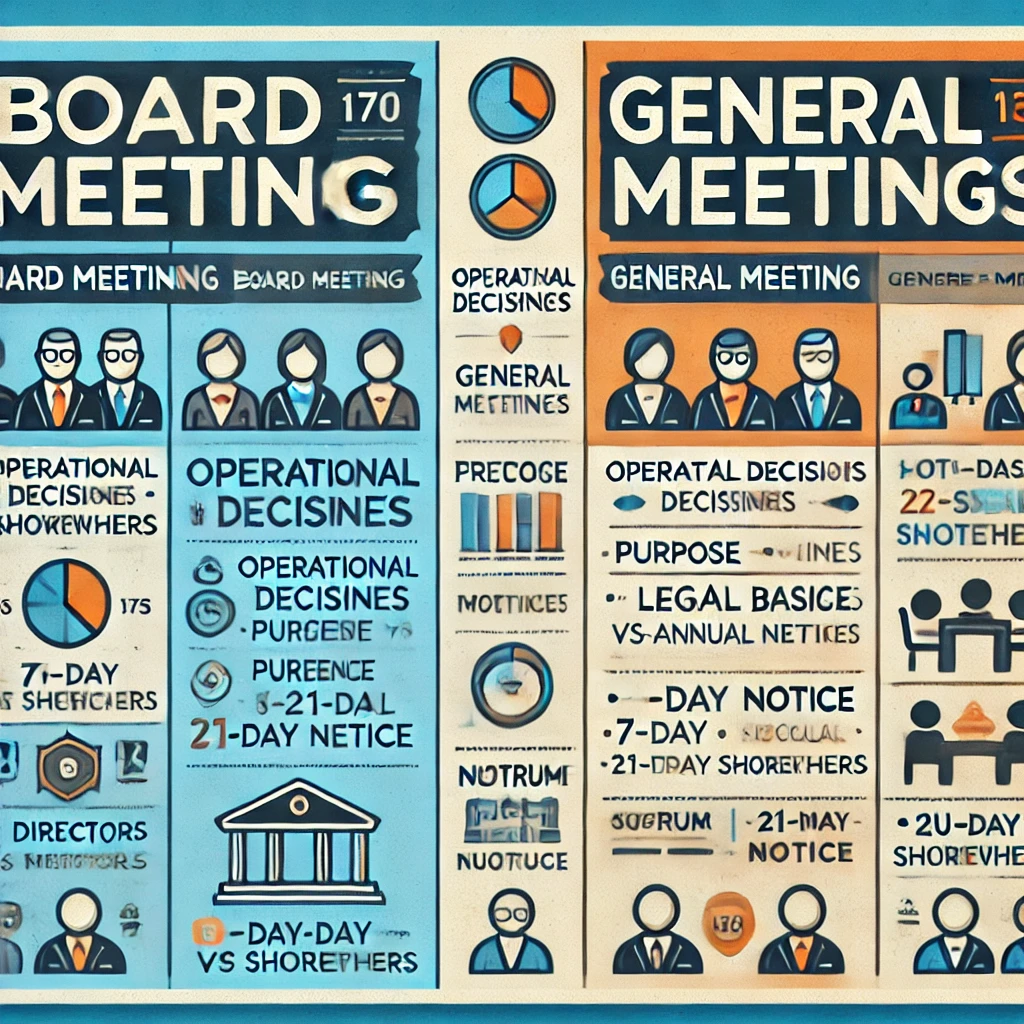Introduction Board Meeting and General Meeting
In the corporate world, meetings serve as crucial platforms for decision-making, communication, and strategy. However, not all meetings are the same. Two common types of formal meetings conducted within a company are board meetings and general meetings. While both aim to ensure smooth functioning and compliance with regulations under the Companies Act 2013, their purposes, participants, and proceedings differ significantly.
Understanding these distinctions is essential for corporate professionals and stakeholders. This blog explores the differences, key aspects, and legal requirements of board meetings and general meetings under the Companies Act 2013 in a beginner-friendly manner, with examples to clarify concepts.
Table of Contents
Board Meeting vs General Meeting
A board meeting is primarily conducted among the company’s directors to make strategic decisions, monitor operations, and discuss corporate policies. These meetings are central to the governance and leadership of the organization. On the other hand, a general meeting involves shareholders or members of the company and focuses on broader issues such as approving annual financial statements, declaring dividends, or appointing auditors.
Key Points of Difference:
- Participants: Board meetings involve directors, while general meetings include shareholders or members.
- Purpose: Board meetings focus on managerial decisions, while general meetings emphasize shareholder interests.
- Frequency: Board meetings occur more frequently, often as needed, whereas general meetings are typically annual or extraordinary.
Example: Imagine a company deciding to launch a new product. The board of directors would discuss the feasibility, risks, and budget in a board meeting. Later, the shareholders might be consulted in a general meeting to approve funding for the project.

Comparison Table Between Board Meeting and General Meeting
| Aspect | Board Meeting | General Meeting |
|---|---|---|
| Definition | A meeting of directors to discuss company strategies and operations. | A meeting of shareholders to discuss company affairs. |
| Participants | Directors and key managerial personnel. | Shareholders or members of the company. |
| Frequency | Regular intervals, as needed (minimum 4 per year for listed companies). | Annual or as needed (AGM or EGM). |
| Purpose | Strategic decisions, operational oversight. | Approvals, major decisions requiring shareholder input. |
| Legal Requirement | Governed by Sections 173-175 of the Companies Act 2013. | Governed by Sections 96-102 of the Companies Act 2013. |
| Notice Period | Minimum 7 days or shorter if agreed by directors. | Minimum 21 days for AGM; shorter for EGM as per regulations. |
| Quorum | Defined by Articles or minimum two directors. | Defined as per Companies Act (e.g., 2-5 members based on company size). |
| Chairperson | Board chairperson or appointee. | Typically the company chairperson or shareholder-elected individual. |
Main Differences Between Board Meeting and General Meeting (Pointwise)
- Participants
- Board Meeting: Board meetings involve the company’s directors and, at times, key managerial personnel (KMP). These individuals are responsible for making strategic and operational decisions critical to the company’s functioning.
- General Meeting: General meetings are attended by the shareholders or members of the company. These include both individual and institutional shareholders who have voting rights to influence significant decisions concerning the company’s overall governance and direction.
- Purpose
- Board Meeting: The purpose of a board meeting is to handle operational and managerial decisions. This includes topics such as approving budgets, strategic planning, and overseeing day-to-day operations.
- General Meeting: General meetings focus on matters related to shareholder interests, such as approving annual accounts, electing directors, declaring dividends, or amending company policies.
- Frequency
- Board Meeting: These meetings are held more frequently. For instance, listed companies are required to hold at least four board meetings annually, with no more than 120 days between two consecutive meetings.
- General Meeting: These meetings occur less frequently. An Annual General Meeting (AGM) is mandatory once a year for certain companies, while an Extraordinary General Meeting (EGM) is convened only when urgent shareholder approval is needed.
- Legal Basis
- Board Meeting: Governed by Sections 173-175 of the Companies Act 2013, board meetings follow specific regulations regarding notice, quorum, and decision-making procedures. The Articles of Association of the company may also provide additional rules.
- General Meeting: Governed by Sections 96-102 of the Companies Act 2013, general meetings follow strict guidelines regarding timing, notice periods, quorum, and voting procedures to ensure transparency and compliance with shareholder rights.
- Notice
- Board Meeting: A minimum notice of 7 days must be given to directors, either through post, electronic means, or hand delivery. However, shorter notice may be allowed for urgent matters if agreed upon by a majority of the directors.
- General Meeting: A minimum notice of 21 days is mandatory for Annual General Meetings (AGM). The notice must include details such as the agenda, date, time, and venue of the meeting. For Extraordinary General Meetings (EGM), the notice period may vary based on urgency but typically requires at least 21 days.
- Quorum
- Board Meeting: The quorum for a board meeting is defined as a minimum of two directors or one-third of the total number of directors, whichever is higher. This ensures that decisions are made with adequate representation of the board.
- General Meeting: The quorum for a general meeting depends on the company’s size. For a private company, two members form a quorum. For a public company, the requirement ranges from two to five members, depending on the number of shareholders.
These differences underline the distinct roles and responsibilities that board meetings and general meetings play in corporate governance, ensuring a balance between operational decision-making and shareholder participation.
Similarities Differences Between Board Meeting and General Meeting
Similarities
- Formal Structure: Both board meetings and general meetings follow a formal structure defined by the Companies Act 2013 and the Articles of Association of the company.
- Decision-Making: Both meetings aim to facilitate decision-making for the company’s growth and compliance.
- Requirement of Notice: A prior notice is required to convene both types of meetings, ensuring participants have sufficient time to prepare.
- Record Maintenance: Minutes of the meetings must be recorded and maintained for both board and general meetings as per legal requirements.
- Chairperson: Both meetings are presided over by a chairperson to ensure order and adherence to the agenda.
- Role in Governance: Both contribute to corporate governance and ensure alignment with legal and operational requirements.
Differences
- Participants:
- Board Meeting: Involves directors and key managerial personnel.
- General Meeting: Involves shareholders or members of the company.
- Purpose:
- Board Meeting: Focuses on managerial and operational decisions.
- General Meeting: Focuses on shareholder-related matters like approving dividends or appointing auditors.
- Frequency:
- Board Meeting: More frequent (minimum four times a year for listed companies).
- General Meeting: Annual or occasional (AGM and EGM).
- Legal Basis:
- Board Meeting: Governed by Sections 173-175 of the Companies Act 2013.
- General Meeting: Governed by Sections 96-102 of the Companies Act 2013.
- Notice:
- Board Meeting: Requires at least 7 days’ notice.
- General Meeting: Requires at least 21 days’ notice for an AGM.
- Quorum:
- Board Meeting: Defined as a minimum of two directors or one-third of the total number of directors.
- General Meeting: Based on the size of the company, typically two to five members.
- Scope:
- Board Meeting: Handles strategic, operational, and policy decisions.
- General Meeting: Focuses on the rights and interests of shareholders.
These points highlight the complementary nature of board meetings and general meetings in maintaining a company’s governance and operational efficiency.
What is a Board Meeting?
A board meeting is a formal gathering of a company’s directors aimed at discussing and deciding on matters essential to the company’s management and direction. These meetings are guided by Sections 173-175 of the Companies Act 2013 and must be conducted as per the company’s Articles of Association.
Key Features of Board Meetings:
- Frequency: For listed companies, at least four board meetings must be held annually, with a gap of no more than 120 days between consecutive meetings.
- Notice: A notice of at least seven days must be sent to all directors. Meetings can occur at shorter notice in case of urgency.
- Agenda: The agenda typically includes topics such as financial planning, risk management, new investments, or mergers.
- Quorum: The Companies Act specifies that a minimum of two directors or one-third of the total directors (whichever is higher) is required to constitute a quorum.
Example: A board meeting might be convened to approve the company’s quarterly financial statements or to consider a merger proposal.
What is a General Meeting?
A general meeting is a forum where shareholders or members convene to deliberate and decide on significant matters affecting the company. These meetings are governed by Sections 96-102 of the Companies Act 2013 and are categorized into two types:
- Annual General Meeting (AGM): Held annually to discuss routine matters like approval of financial statements and the appointment of directors or auditors.
- Extraordinary General Meeting (EGM): Called to address urgent matters that cannot wait until the AGM.
Key Features of General Meetings:
- Participants: Includes all shareholders or members entitled to vote.
- Notice: A 21-day notice is mandatory, along with the meeting agenda.
- Agenda: Common issues include declaring dividends, revising company bylaws, or approving major transactions.
- Quorum: Defined based on the company’s size, e.g., two members for small companies and five for larger ones.
Example: Shareholders gather at the AGM to approve the directors’ recommendation for dividends.
Main Differences Between Board Meeting and General Meeting (Pointwise)
- Participants: Board meetings involve directors; general meetings involve shareholders.
- Purpose: Board meetings handle operational decisions; general meetings deal with shareholder interests.
- Frequency: Board meetings are frequent, while general meetings are annual or special.
- Legal Basis: Board meetings are governed by Sections 173-175; general meetings by Sections 96-102 of the Companies Act 2013.
- Notice: Board meetings require a 7-day notice, while general meetings require a 21-day notice.
- Quorum: The quorum for board meetings depends on the number of directors, while general meetings depend on the company size.
Conclusion Board Meeting and General Meeting
Board meetings and general meetings play distinct yet complementary roles in corporate governance. While board meetings focus on management and strategic decision-making, general meetings prioritize shareholder interests and democratic participation. Understanding these differences is vital for ensuring compliance with the Companies Act 2013 and fostering effective corporate governance. By aligning the objectives of both meetings, companies can achieve better transparency, accountability, and decision-making efficiency.

